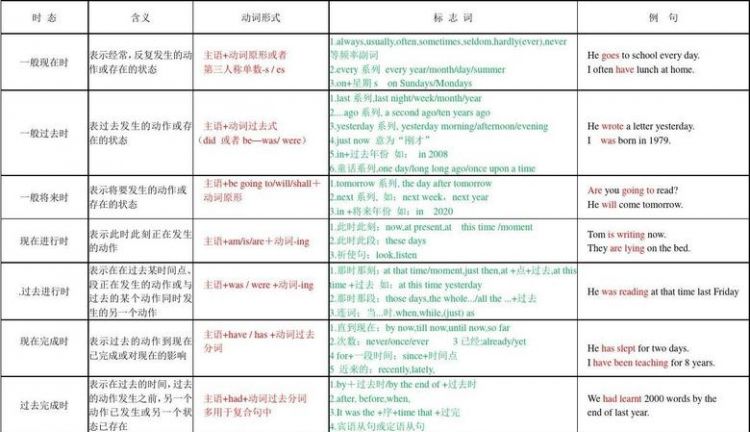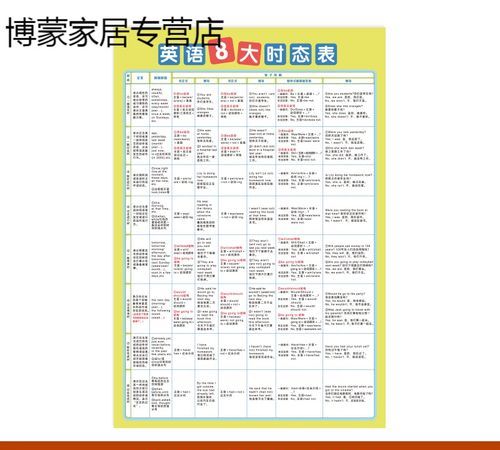本文目录
初中英语八大时态的构成,标志词
一、 一般现在时
例句:
It seldom snows here.
He is always ready to help others.
Action speaks louder than words.
二、 一般过去时
例句:
She often came to help us in those days.
I didn't know you were so busy.
三、 现在进行时
例句:
How are you feeling today?
He is doing well in his lessons.
四、 过去进行时
例句:
At that time she was working in a PLA unit.
When he came in,I was reading a newspaper.
五、 现在完成时
例句:
I've written an article.
The countryside has changed a lot in the past few years.
六、 过去完成时
例句:
As soon as we got to the station,the train had left.
By the end of last month.We had reviewed four books.
七、 一般将来时
例句:
They are going to have a competition with us in studies.
It is going to rain.
八、 过去将来时
例句:
He said he would go to Beijing the next day.
I asked who was going there.
九.将来完成时
例句:
By the time you get back,great changes will have taken place in this area.
初中阶段只需要掌握以上这些.

初中英语八大时态总结表以及题专练
学好时态基本就拿下了语法的半壁江山,时态的学习至关重要,很多学生认为时态的种类太多,总是太容易记混。下面是英语时态总结,供大家参考。
一般现在时
1.概念:经常、反复发生的动作或行为及现在的某种状况。
2.句子结构:主语+do/does(现在分词)
3.时间状语:always, usually, often, sometimes, every week (day, year, month…), once a week, on Sundays...
4.否定形式:①am/is/are+not;②此时态的谓语动词若为行为动词,则在其前加don't,如主语为第三人称单数,则用doesn't,同时还原行为动词。
5.一般现在时通常表示:(1)表示一直发生的事情,经常发生的动作;(2)表示客观事实或者真理;(3)谈论时间表、旅程表等;(4)谈论籍贯、国籍等。
6.一般疑问句:①把be动词放于句首;②用助动词do提问,如主语为第三人称单数,则用does,同时,还原行为动词。
一般过去时
1.概念:过去某个时间里发生的动作或状态;过去习惯性、经常性的动作、行为。
2.句子结构:主语+did
3.时间状语:ago, yesterday, the day before yesterday, last week(year, night, month…), in 1989, just now, at the age of 5, one day, long long ago, once upon a time, etc.
4.否定形式:①was/were+not;②在行为动词前加didn't,同时还原行为动词。
5.一般疑问句:①was或were放于句首;②用助动词do的过去式did 提问,同时还原行为动词。
现在完成时
1.概念:过去发生或已经完成的动作对现在造成的影响或结果,或从过去已经开始,持续到现在的动作或状态。
2.句子结构:have/has + done
3.时间状语:recently, lately, since…for…,in the past few years, etc.
4.否定形式:have/has + not +done.
5.一般疑问句:have或has。
现在进行时
1. 概念:表示现阶段或说话时正在进行的动作及行为。
2. 时间状语:now, at this time, these days, etc.
3. 基本结构:am/is/are+doing
否定形式:am/is/are+not+doing.
一般疑问句:把be动词放于句首。
4. 用法:
(1)表示现在(指说话人说话时)正在发生的事情。
例如: We are waiting for you. 我们正在等你。
(2)习惯进行:表示长期的或重复性的动作,说话时动作未必正在进行。
例如:Mr. Green is writing another novel. 他在写另一部小说。(说话时并未在写,只处于写作的状态。)
(3)表示渐变,这样的动词有:get, grow, become, turn, run, go, begin等。
例如:The leaves are turning red. 叶子在变红。
It's getting warmer and warmer. 天越来越热了。
(4)与always, constantly, forever 等词连用,表示反复发生的动作或持续存在的状态,往往带有说话人的主观色彩。
例:You are always changing your mind. 你老是改变主意。
(5)用现在进行时表示将来
下列动词come, go, arrive, leave, start, begin, return等瞬时动词的现在进行时可以表示将来。
例:I'm leaving tomorrow. 明天我要走了。
Are you staying here till next week? 你会在这儿呆到下周吗?
过去进行时
1. 概念:表示过去某段时间或某一时刻正在发生或进行的行为或动作。
2. 时间状语:at this time yesterday, at that time或以when引导的谓语动词是一般过去时的时间状语等。
3. 基本结构:was/were+doing
否定形式:was/were + not + doing.
一般疑问句:把was或were放于句首。
4. 用法
(1)过去进行时表示过去某段时间内持续进行的动作或者事情。
We were watching TV from seven to nine last night.
昨天晚上七点到九点的时候我们在看电视。
(2)过去进行时可以表示在过去某个时间点发生的事情。时间点可以用介词短语、副词或从句来表示。
What was she doing at nine o'clock yesterday?
昨天晚上九点她在做什么? (介词短语表示时间点)
She was doing her homework then.
那个时候她正在写作业。(副词表示时间点)
When I saw him he was decorating his room.
当我看见他的时候他正在装饰房间。 (when从句表示时间点)
(3)在复合句中,如果主要动作和背景动作都是延续的或同时发生的,那么主从句的动词都可用过去进行时。
When he was waiting for the bus, he was reading a newspaper.
他边等车边看报。 (两个动作都是延续的)
He was cleaning his car while I was cooking.
他擦车时我在做饭。(两个动作同时进行)
一般将来时
1.概念:表示将要发生的动作或存在的状态及打算、计划或准备做某事。
2.时间状语:tomorrow, next day(week, month, year…),soon, in a few minutes, by…,the day after tomorrow, etc.
3.基本结构:①am/is/are/going to + do;②will/shall + do.
4.否定形式:①was/were + not; ②在行为动词前加didn't,同时还原行为动词。
5.一般疑问句:①be放于句首;②will/shall提到句首。
过去将来时
1.概念:立足于过去某一时刻,从过去看将来,常用于宾语从句中。
2.时间状语:the next day(morning, year…),the following month(week…),etc.
3.基本结构:①was/were/going to + do;②would/should + do.
4.否定形式:①was/were/not + going to + do;②would/should + not + do.
5.一般疑问句:①was或were放于句首;②would/should 提到句首。
6.用法
(1)“would+动词原形”常表示主观意愿的将来。
例:He said he would come to see me.
他说他要来看我。
(2)“was/ were+going to+动词原形”常表示按计划或安排即将发生的事。
例:She said she was going to start off at once.
她说她将立即出发。
此结构还可表示根据某种迹象来看,很可能或即将发生的事情。
It seemed as if it was going to rain.
看来好像要下雨。
(3)come, go, leave, arrive, start等瞬时动词动词可用过去进行时表示过去将来的含义。
过去完成时
1.概念:以过去某个时间为标准,在此以前发生的动作或行为,或在过去某动作之前完成的行为,即“过去的过去”。
2.时间状语:before, by the end of last year(term, month…),etc.
3.基本结构:had + done.
4.否定形式:had + not + done.
5.一般疑问句:had放于句首。

英语八大时态总结表
时态是英语学习中一个至关重要的内容,我们在实际运用时,往往对时态倍感棘手,下面我们就归纳复习一下这几种时态的用法。
一般现在时
概念:经常、反复发生的动作或行为及现在的某种状况。
时间状语:always, usually, often, sometimes, every week (day, year, month…), once a week, on Sundays, etc.
基本结构:①be动词;②行为动词
否定形式:①am/is/are+not; ②此时态的谓语动词若为行为动词,则在其前加don't,如主语为第三人称单数,则用doesn't,同时还原行为动词。
一般疑问句:①把be动词放于句首;②用助动词do提问,如主语为第三人称单数,则用does,同时,还原行为动词。
一般过去时
1.表过去发生的事情或存在的状态
eg Suddenly,the clouds cleared and the rain stopped.
2.表过去经常发生的事情
eg I was very thin in my childhood.
3.带有确定的过去的时间状语
eg Did you meet yesterday? He left just now.
现在进行时
1.说话、写文章的当刻正在发生的动作
eg They are having a football match.
2.现阶段一直在进行的动作
eg He is preparing for CET Band Six.
3.表示说话人的情感,如赞许、批评等
eg She is often doing well at school.
4.表示在近期按计划或安排要发生的动作
eg Are you staying here till next week?
过去进行时
1.概念:表示过去某段时间或某一时刻正在发生或进行的行为或动作。
2.时间状语:at this time yesterday, at that time或以when引导的谓语动词是一般过去时的时间状语等。
3.基本结构:was/were + doing
4.否定形式:was/were + not + doing.
5.一般疑问句:把was或were放于句首。
现在完成时
概念:过去发生或已经完成的动作对现在造成的影响或结果,或从过去已经开始,持续到现在的动作或状态。
时间状语:recently, lately, since…for…,in the past few years, etc.
基本结构:have/has + done
否定形式:have/has + not +d one.
一般疑问句:have或has。
过去完成时
1.概念:以过去某个时间为标准,在此以前发生的动作或行为,或在过去某动作之前完成的行为,即“过去的过去”。
2.时间状语:before, by the end of last year(term, month…),by the time...,etc.
3.基本结构:had + done.
4.否定形式:had + not + done.
5.一般疑问句:had放于句首。
一般将来时
概念:表示将要发生的动作或存在的状态及打算、计划或准备做某事。
时间状语:tomorrow, next day(week, month, year…),soon, in a few minutes, by…,the day after tomorrow, etc.
基本结构:①am/is/are/going to + do;②will/shall + do.
否定形式:①was/were + not; ②在行为动词前加didn't,同时还原行为动词。
一般疑问句:①be放于句首;②will/shall提到句首。
过去将来时态
表示过去的某时以后将要发生的动作。但这个"将来"时间绝不会延伸到―现在;而仅限于―过去时间区域内。由此可以看出,含这个时态的句子常带一个表示―过去某个时间点的状语。这个状语或是一个短语,或是一个句子。这个时态常用于:
1.结构
a)would/should+动词原形
b)was/were going to+动词原形
2.用法
1)、表示从过去某时看将要发生的动作或存在的状态。常用于主句是一般过去时的宾语从句或间接引语中。
2)、表示过去的某种习惯性动作,只能用would。
3)表示过去情况中的―愿望、―倾向,多用于否定句。

初中所学的英语时态有哪些
(一)一般现在时。(do/does, am/is/are, 情态动词)
一般现在时表示的是客观事实或平时反复做的事情通常有频率副词always,usually,often,sometimes,seldom,once a week,every day等。
如:The earth goes around the sun.
Japan lies east of China.
He is never late for school.
He often gets up at six every day.
Cats can climb trees.
I hear they have moved into a new house.
He writes to his father once a year.
一般现在时还可以表示、安排好的,或即将发生的事,通常使用瞬间动词come,start,begin,return,leave等。
如:My plane leaves at 6:00 a.m..
Is there any meeting today?
The game starts at 8:00.
(二)现在进行时。(am/is/are doing)
现在进行时表示现在或最近正在做的事情,后面一般接延续性的动词,都表示动作没有进行完。
如:Look! The boy is dancing.
He is watching a football game.
What are you doing now?
They are preparing for the exam recently.
还常与always,usually,constantly,forever,continually等词连用表示一种语气,“总是,老是…”,
如:He is always working late.
Why are you always making this kind of mistake?
He is continually getting into trouble with the police.
后面接暂转动词时表示正在反复的动作,或表示将来时(一般只有go, come, leave和have)
如:The monkeys are jumping.
They are hitting the tree.
表将来:We are going swimming this afternoon.
They are leaving here.
They are having an English class tomorrow.
试比较:
He is doing his homework until his parents come to take him home.
He will do his homework until his parents come to take him home.
注:表示知觉、感觉、看法、认识、情感或愿望的动词和大部分暂转动词不能用现在进行时,如:see, hear, smell, taste, feel, like, hate, dislike, want, love, hate, want, know, forget, remember, understand, believe, suppose, mean, wish, hope, need, believe, refuse, suppose, have, fit, seem, fear, own等
(三)现在完成时
现在完成时中用瞬间动词表示说话时已经完成的动作,而且这个动作对现在还有影响,句中的时间副词主要有already, yet, now, by this time, by now等;用延续动词表示过去已经开始持续到现在而且还有可能继续持续下去的动作,句中的时间副词主要有this week, in the past/last/recent few years, since…, for…。
如:He has already finished his homework.
He hasn’t arrived here yet.
They have been here for ten years.
He has waited here since he came.
与一般过去时比较,看下面一段对话:
A: Have you seen my book? I think I have lost it.
B: Yes, I ______ (see) it on your table just now. But it ______(not be) there any longer. Where and when ______ you ______(lose) it?
A: I think I ______ (lose) it yesterday.
B: ______ you ______ (find) it?
A: ______.(Yes./No.)
现在完成时中的瞬间动词与延续动词的相互转化:
have finished/stopped/ended → have been over
have started/begun → have been on
have joined → have been in/a member of
have turned/become/got → have been
have left → have been away from
have arrived/reached/got to → have been
have died → have been dead
have married/got married to sb. → have been married to sb.
(四)一般将来时。(will/shall do, am/is/are going to do, am/is/are doing, am/is/are about to do)
一般将来时表示将要发生或打算做的事情,
如:He will come back in two days.
When will he give the book back to me?
It’s going to rain.
We are going to hold a sports meeting next week.
They are leaving for New York.
He is about to leave.
(五)一般过去时。(did, was/were, 情态动词过去式)
一般过去时表示在过去的某个时间发生的具体事情,一般都要有表示过去的时间状语,
如:He went to school by bike yesterday.
We had a good time last night.
He could count to 1000 when he was three.
He was a teacher before.
注意:在直接引语转换成间接引语时时间状语的变化:
如:He said, “I did it yesterday.”
→ He said he did it the day before.
today → that day
yesterday → the/a/one day before
the day before yesterday → 2 days before
last week → the week before
2 weeks ago → 2 week before
tomorrow → the next day/the day after或one/a day later
the day after tomorrow → 2 days after/later
in a week/next week → the next week
in 2 weeks → 2 weeks after/later
(六)过去进行时。(was/were doing)
过去进行时表示在过去的某个具体时间里正在发生的事情,
如:He was reading newspaper at seven yesterday evening.
The Smiths are watching TV at nine last night.
When he got home, his mother was cooking.
或过去的某段时间里持续发生的事情,
如:I was studying English in London from 1990 to 1992.
He was washing the dishes from seven o’clock to seven thirty.
(七)过去完成时
表示在过去的一个动作之前就已经完成的动作,即过去之过去。注意与现在完成时不同的是过去完成时必须要有具体的时间状语。
如:The train had left before she got to the station.
They had learnt 2000 words by the end of last month.
He had been a doctor for 3 years before he came here.
He got back the book that he had left in the classroom.
No sooner had he got to the cinema than the film began.
Hardly had he got to the cinema when the film began.
注意:如果两个或几个动作连续发生且衔接紧密时用一连串的一般过去式即可。
如:He locked the door and went away.
Mr.Smith went to the market, bought some flowers and went to see his friends.
He sent a telegraph home before he left Paris.
(八)过去将来时。(would/should, was/were going to do, was/were doing)
过去将来时表示在过去某时就打算做的事情,或相对于过去将要发生的事情。
如:They were going swimming when I met them.
He said he would go to New York.
Yesterday he said it was going to rain, but it didn’t.
(九)复合时态。高中阶段所学到的复合时态主要有:
完成进行时,将来完成时和将来进行时。
完成进行时表示到目前为止一直在做某事。过去完成进行时还可以表示刚刚结束的进行动作。
如:He has been painting the house the whole morning.
They have been promising us to rise our salary these years.
They had been doing their homework for 3 hours before I came.
I asked him what he had just been doing?
He had just been sleeping before I got there.
将来完成时表示,到将来某时即将结束的动作。
如:We will have learnt 3000 English words by the end of next term.
They will have finished it by 12:00 tomorrow.
将来进行时表示将来某时正在进行的动作。
如:We will be sleeping at this time tomorrow.
She will be waiting there at 8 a.m. if you ask her to.

以上就是关于八大时态标志词大全表格 ,初中英语八大时态的构成,标志词的全部内容,以及八大时态标志词大全表格 的相关内容,希望能够帮到您。
